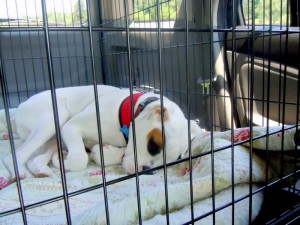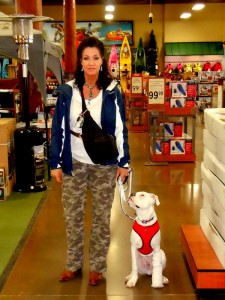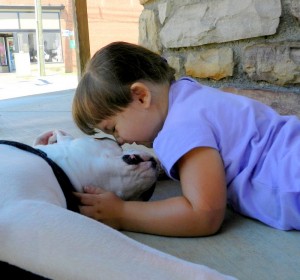These are tips I have learned owning Nitro. I am not in any way a professional dog trainer. These are common sense tips for deaf dog training. You may have some to add to this list but these are the tips I think are crucial in owning, training and socializing a deaf dog. One of the most important aspects I have learned training Nitro is he knows no matter what situation we are in, I always have his back no matter what. This helps his confidence level more than anything else you can do for your dog. He has never been punished but I always redirect his bad behavior to something positive. He knows what a “no” sign means because I also have a scowl on my face when I give him the “no” sign. You must never strike a deaf dog with your hands because your hands are his/her communication to the world. Your hands must be a positive tool you use to communicate. Always be very patient with your deaf dog.
Take a Class
1. Get started early with training when you first get your deaf puppy. Since Nitro was deaf we enlisted him in a Puppy class at Field of Dreams Dog Training Center to teach him to look at me often. We encourage you to only consider using Positive Reinforcement Clicker Training facilities. If you are not familiar with this kind of training it is a positive approach to training your dog by you giving your dog a “sign command”, using a high value treat to lure your deaf dog/puppy into place like using the “sit” sign. When you dog “sits” then you would normally mark the correct response with the sound of a clicker and then treat the dog. The only difference with a deaf dog is you will tweak the training and use a visual sign for the command and a visual sign instead of the sound of a clicker to mark the dog’s correct response to a command. Read each website carefully when researching trainers in your area. When I search for trainers for people in our community I run a across “Positive Training” on some training facilities home page but with further investigation they are anything but positive. Read more about Positive Reinforcement Clicker Training here.
We encourage deaf dog owners in our community to put an emphasis on Positive Reinforcement Training methods so that you can watch your deaf dog become a trusted partner through shared experience, communication, and trust. Your deaf dog will choose to work forward and advance without force or intimidation. You will witness your deaf dog becoming a willing and eager participant in learning as much as he/she can with you as a partner. With a strong Positive Reinforcement Training foundation, there is no limits to the great canine citizen your deaf dog can become.
2. Get training at a training facility in a group setting with other dogs so you will be committed to going to school at least 2 to 3 times per week. We signed up for 6 months to make sure we had a solid training foundation and we continued on and off for two years.
3. Nitro started in puppy class so we highly recommend puppy class to teach your puppy the basics of eye contact so the puppy always looks at his handler for direction. Puppy class is great because it also teaches each handler about positive reinforcement. Since the school we went to does “clicker” training, I decided Nitro’s “clicker” would be a three finger (middle finger, ring finger and little finger) flash of my hand. This worked very well because I could mark his good behavior and at the same time the three finger flash allows me to hold a treat in my thumb and index finger. Some of our deaf dog owners will use a “thumbs up” sign and a smile for their marker to mark the correct response from their dog.
4. Be sure to help your dog be the best he can be by crate training your dog. When Nitro was going through crate training (a must with a puppy), I always used a leash to take him out to do his business even though I have a fenced yard. I would give him the ASL T sign (for toilet) so he knew right away if he was on a leash in the back yard he was there to do his business. What this does is teach him the “go potty” sign. Click here for Potty Training your deaf dog. Nitro took a very long time to crate train because he had a urinary tract infection. If you find your deaf dog is not getting the crate training and having accidents when he is in his crate, you might have to get the dog checked out by a vet. Nitro took 8 weeks to crate train at 100% but he had an infection for two of those weeks at the beginning of training. Now when we are going places and I give him the “go potty” sign he actually goes on command.
Seek Out Social Opportunities and Stimuli
5. If you have a dog park where you live, try to visit the park with your dog at least once a week so your dog can play off leash and learn to develop relationships on his/her own without being subject to every move they make being controlled by a human. This works very well if you can get your dog to look at you often and make sure he has a good recall before you turn him loose. Nitro is trained on a vibration collar (not a shock collar). Whenever I push the button he gets treated by looking at me so when we are at a dog park he can go play with other dogs. When I push the button, he feels the vibration and he looks in my direction so I can recall him.
Be sure to address bite inhibition training when your dog is a puppy or when you feel your new adopted dog is comfortable with you.
6. If you have a smaller dog like we do you do, you will need to focus on bite inhibition as soon as you get your puppy. Puppy mouthing is 100% natural dog behavior. It’s just a puppy being a puppy. Traditional bite inhibition is when a hearing dog can hear another dog yelp so it knows to let go. When training a hearing dog the trainer would yelp to get the dog to stop and then walk away. With Nitro being deaf and our pack having two small dogs, I feared one of our little dogs would get hurt especially my 8 pound Tallulah. What I did to teach Nitro to be gentle was teach him my “gentle” sign by slowly running one hand over the top of the other hand and saying gentle. If he played rough, I would not hesitate to take Tallulah away from Nitro, give him the gentle sign so he would learn that if he was rough all the fun would stop.
When Nitro first came to live with us I would sit on the floor with both of them when they played. If Tallulah would yelp when Nitro bit down to hard, I would put my thumb to the roof of his mouth and hold his nose up with my thumb pushing on the roof of his mouth (hold it for a few seconds), then give the gentle sign. I felt guilty having to do this training but can you imagine how bad I would feel if he hurt Tallulah or a small child. This training method taught him to play with his mouth open like my older dogs do now. The bite inhibition training worked really well when he was 10 to 16 weeks old. Note: This worked well on Nitro but each dog is different so you have to take into account your dog’s personality to begin with. Nitro is very sensitive and it only took 2 or 3 corrections and he got the “gentle” sign right away. If you notice your dog snapping or growling when you do this then stop and try another method or just make all play STOP.
Now when he plays rough (which is rare), I just walk over, pick Tallulah up, give him the gentle sign and walk away (and make a concerned look on my face). I do the same thing if he gets mouthy with my hands. I get up immediately and walk away. Always lift your hands away from the dog and turn and walk away. The dog will learn very fast when he bites down all fun immediately stops. Click here for other training methods.
7. When you first get your deaf dog, be sure to try to take it for rides in your car often. Start in the puppy stages if that is all possible. Getting your dog used to seeing strangers, different situations and other dogs from the car is a good start. Make sure they have a safe place in the car. We purchased an additional a crate to be secured in the back seat of our car because an 80 pound dog can be a 2400 pound projectile flying through the air in an auto accident. Also puppies like to chew so if there is a crate in your car and you need to run errands you won’t come back to your leather seats being chewed up by your dog (this happened to a friend of mine and he was a very unhappy camper).
8. My dog Nitro goes to Petsmart, Petco, Starbucks, Panera and Lowes weekly. I have an outing with him every morning to work on socialization. I realize many dog owners work and can’t do the off site training everyday but if you can, try to sneak it in on the weekends. Maybe you could make up for lost time from your work schedule during the week. We practice loose leash training every opportunity we get. If you do this while your dog is a puppy, it way pay off big time when he is 60+ pounds. When Nitro pulls on his leash, I turn around and go the opposite direction so he learns if he pulls, he isn’t going to get where he wants to go.
9. Take your dog to busy, high traffic stores that allow dogs and outside dining establishments (see dining etiquette for dogs here). What this does is desensitize the dog. Make sure you carry a pouch loaded with high value treats (I cut little pieces of hot dog our lunch meat). It helps to have treats handy for any situation just in case you need to get the dogs attention to sit and stay while he/she is being greeted. Treats help redirect the dog’s distraction back to focusing on the handler. Keep all outings short and upbeat. Try to end on a happy note. You can start to extend your time on your outings as the dog progresses and shows confidence in his surroundings. When I first get to a busy store or outing, I allow about 5 to 10 minutes for Nitro to settle down. I usually lose his eye contact for the first 5 minutes because he is looking around and taking in everything around him. As soon as I get his focus back on me (by treating him), then and only then do we continue our training exercise in high traffic areas.
Watch your body language because dogs pick up on their handler’s anxiety. Try to go easy on restraining your dog when he/she is being introduced to other dogs
10. When meeting and greeting other dogs try not to pull hard on the leash because this puts the dogs in a protective almost aggressive stance. We also use a collar and a work vest (from fetchdog.com) and I have a special leash from Kong that feeds through the collar and the vest to distribute pressure throughout the dogs upper torso (it is also a double fail system in case a clip on the collar were to fail there is still a clip on the vest attached to the leash). Nitro has learned if he wants to meet someone he must sit down before anyone can approach him. I have also taught him to lay down for small children and other dogs when they greet him so he will never be perceived as a threat.
Be sure to always watch your dog’s body language for signs of discomfort, fear or aggression
11. Watch for signs of fear or aggression. Do not force your dog into a situation that has the potential to end badly. Nitro and I were at Starbucks one day and a man tried to introduce his dog to Nitro and I could tell from his dog’s body language it was not comfortable (and he had a shock collar around his neck so I knew the dog was terrified of getting zapped at any moment) I stood up and asked the gentleman to please not approach my dog while his dog look distressed. This is a perfect example of watching for another dog’s body language. Never ever feel bad about asking someone not to pet or approach your dog with their dog or a small child if you are training or don’t feel comfortable with the situation.
Enlist help from friends, family or neighbors
12. Socializing at home is wonderful if you can get a friend, family member or neighbor who is willing to come over to your home often to knock on the door or ring the bell. Start with a leash on your dog at first. Teach your dog to sit in a certain area or spot (on a rug away from the door or in another room). Always be ready with treats to distract the dog and make him sit and stay. The first couple of training sessions you might have to treat, treat, treat to keep your dog focused and then slowly wean them off the treats. Be sure to give your visitor treats beforehand to feed to the dog so the dog knows the visitor is a friend.
Be sure to get professional help if you see signs of fear or aggression. If you have adopted an older dog with socialization issues it is always wise to get professional help.
13. If you have adopted an older dog with socialization issues such as aggression please be sure to get professional help. I take Nitro to Field of Dreams Dog Training Center and we have many people who bring in their older adopted dogs in for special training. I have witnessed some of these dogs start the program with aggressive behavior or fear of the unknown. With time, love and patience, these dogs make huge strides. We take the entire class on “loose leash” walks around the downtown area when the weather permits. Walking in these casual groupings teaches the dogs that things aren’t so bad and it really helps them calm down and get used to being around other dogs and their owners.
14. If you decide to use a vibration collar, here is a great training video to watch to get you started.
If you have some great tips when training your deaf dog, we would love to hear from you. Please send all tips to christina@deafdogsrock.com
Please Read:
Please consider if your dog is having serious behavioral issues, please contact a professional for an evaluation and tips on how you can improve your situtaion. The tips shared here are from my personal experience and I am not a professional trainer. Nothing I write on this blog can take place of a meeting with a trained K9 dog training professional.
Nothing on this website or any tips given by Deaf Dogs Rock or Christina Lee will be held responsible for any incidents related directly or indirectly to the materials published on DeafDogsRock.com. Christina Lee or DeafDogsRock.com assumes no liability or responsibility for any of your actions taken after reading our published material on this site.





















